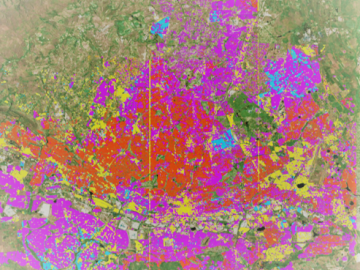
Filter News
Area of Research
- Advanced Manufacturing (6)
- Biological Systems (1)
- Biology and Environment (4)
- Building Technologies (1)
- Clean Energy (60)
- Climate and Environmental Systems (2)
- Computational Engineering (1)
- Computer Science (8)
- Fusion Energy (6)
- Materials (55)
- National Security (5)
- Neutron Science (23)
- Nuclear Science and Technology (11)
- Quantum information Science (3)
- Supercomputing (31)
- Transportation Systems (1)
Date
News Topics
- 3-D Printing/Advanced Manufacturing (15)
- Advanced Reactors (7)
- Artificial Intelligence (12)
- Big Data (7)
- Bioenergy (9)
- Biomedical (5)
- Biotechnology (1)
- Clean Water (5)
- Composites (2)
- Computer Science (35)
- Cybersecurity (5)
- Energy Storage (8)
- Environment (19)
- Exascale Computing (2)
- Frontier (2)
- Fusion (5)
- Grid (5)
- Isotopes (1)
- Machine Learning (5)
- Materials Science (20)
- Mercury (1)
- Microscopy (5)
- Molten Salt (1)
- Nanotechnology (6)
- Neutron Science (18)
- Nuclear Energy (17)
- Physics (6)
- Polymers (2)
- Quantum Science (10)
- Security (2)
- Space Exploration (4)
- Summit (9)
- Sustainable Energy (8)
- Transportation (12)
Media Contacts

OAK RIDGE, Tenn., March 20, 2019—Direct observations of the structure and catalytic mechanism of a prototypical kinase enzyme—protein kinase A or PKA—will provide researchers and drug developers with significantly enhanced abilities to understand and treat fatal diseases and neurological disorders such as cancer, diabetes, and cystic fibrosis.

The unique process of accepting a new supercomputer is one of the most challenging projects a programmer may take on during a career. When the Oak Ridge Leadership Computing Facility’s (OLCF’s) Verónica Melesse Vergara came to the United States from Ecuador in 2005, she never would have dreamed of being part of such an endeavor. But just last fall, she was.

A residential and commercial tower under development in Brooklyn that is changing the New York City skyline has its roots in research at the Department of Energy’s Oak Ridge National Laboratory.

OAK RIDGE, Tenn., March 13, 2019 – Two technologies from the Department of Energy’s Oak Ridge National Laboratory have received national Excellence in Technology Transfer awards from the Federal Laboratory Consortium for Technology Transfer: “Qrypt Licensing of Quantum Random Number Generator from ORNL” and “Strategic Licensing of the LandScan/LandCast Population Datasets.”

OAK RIDGE, Tenn., March 11, 2019—An international collaboration including scientists at the Department of Energy’s Oak Ridge National Laboratory solved a 50-year-old puzzle that explains why beta decays of atomic nuclei

As the rise of antibiotic-resistant bacteria known as superbugs threatens public health, Oak Ridge National Laboratory’s Shuo Qian and Veerendra Sharma from the Bhaba Atomic Research Centre in India are using neutron scattering to study how an antibacterial peptide interacts with and fights harmful bacteria.
Higher carbon dioxide levels caused 30 percent more wood growth in young forest stands across the temperate United States over a decade, according to an analysis led by Oak Ridge National Laboratory.

Oak Ridge National Laboratory is using ultrasonic additive manufacturing to embed highly accurate fiber optic sensors in heat- and radiation-resistant materials, allowing for real-time monitoring that could lead to greater insights and safer reactors.

Geospatial scientists at Oak Ridge National Laboratory analyzed three cities of varying infrastructures to look for patterns of electricity use and locate “dark spots” where informal neighborhoods may lack access to power.

Oak Ridge National Laboratory’s latest Transportation Energy Data Book: Edition 37 reports that the number of vehicles nationwide is growing faster than the population, with sales more than 17 million since 2015, and the average household vehicle travels more than 11,000 miles per year.


